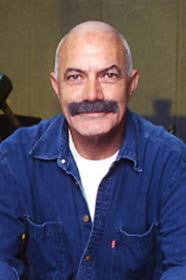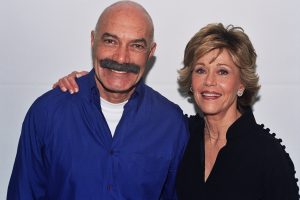Almodovar’s Spanish Comedy
(Que he hecho yo para merecer esto?)
The outrageous black comedy, “What Have I Done to Deserve It?” (“Que he hecho yo para merecer esto?”), Almodovar’s fourth feature of 1984, put him on the movie map in America as a major talent to watch.
After premiering to sold-out crowds as part of New Directors/New Films series, co-sponsored by the New York Film Festival and the Film Department of the Museum of Modern Art. “What Have I Done” became the first Almodovar picture to be released theatrically in the U.S. The director could not have been happier that its successful run led to the release of his three former features, even if they all got mixed reviews (compared to “What Have I Done”).
One of Almodovar’s most naturalistic features, “What Have I Done” is a working-class serio-comedy, in which most of the action unfolds within recognizable settings. The pre-credit sequence reveals a wintry Madrid Square as a film crew is passing by, while a middle-aged woman is seen in the background. The camera moves in on the woman—Gloria (Carmen Maura)—a downtrodden housewife, as she looks back at a film crew nailing some signs to be used in a movie.
Gloria struggles to make ends meet with cleaning jobs, in addition to her regular, exhausting work in her own apartment. At first sight, Gloria is on her knees scrubbing the floor. Looking up, she faces the kendo students in their costumes practicing moves in the martial arts academy. The next shot places Gloria and the students together in the same frame, indicating their paths would criss-cross. Gloria imitates the blows made by the players, using her mop as a substitute for martial club.
Sexually frustrated, Gloria gets excited by the sight of muscular men playing at Kendo. She unabashedly faces one of the men in the gym’s showers, scaling him up and down, including his genitals. During the attempted sexual act, Gloria is fully clothed, while the man is naked. The man, who happens to be a policeman, turns out to be an impotent, and the irony is not lost on Almodovar that this archetypal male, a symbol of political power and sexual potency, fails to perform, not to mention that he has a small, flaccid penis. Disappointed, Gloria picks up the phallic-shaped Kendo. Later on, she uses the same assertive position to kill her husband.
Gloria lives with her macho husband, Antonio (Angel de Andres Lopez), a cab driver, her mother-in-law, and their two sons in a shabby, luridly decorated apartment located by the Madrid motorway. Antonio, who had worked in Germany, still longs for his former employer-mistress, Ingrid Muller (Katia Loritz). Antonio’s services for Ingrid involved copying letters that she had allegedly received from Hitler himself. Antonio casually mentions this fact to his client Lucas, and Lucas suggests that they forge Hitler’s diaries for big profit.
Meanwhile, Gloria is desperate to find extra money to pay the bills. Early on, Gloria, who is addicted to sedatives, goes to a pharmacy to get No-Doz. But the pharmacist, a big chubby woman with peroxided blond hair and big stilt-like eyes, denies her request. The pharmacist refuses Gloria the pills with overt contempt, which is the way Almodovar had scripted the role. But he extended her reaction after casting a real pharmacist he had accidentally met. Incidentally, pharmacists abound in Almodovar’s work, usually portrayed in a negative way, denying service and pleasure (if it’s drugs) to their clients (See “All About My Mother”).
While Gloria is struggling with her own problems, her sons are forced to learn their own survival strategies. The elder son, Juan (Kiti Manvers), deals in drugs, while the younger one, Miguel (Miguel Angel Herranz), sleeps around with older men. When Gloria confronts Miguel, telling him she knows he has been sleeping with older men (including his friend’s father), Miguel responds: “I’m the master of my own body.”
In a poignant scene, heartbreaking but funny, Gloria agrees to “sell” Miguel to a pedophile, a nameless character referred to as Dentist, (Javier Gurruchaga) after shrewdly negotiating with the dentist his duties, her benefits, and other material conditions. The dentist is deliberately constructed by Almodovar as an effeminate homosexual—and a predatory at that.
Having been refused sedatives, the defeated Gloria returns home to find her husband preparing to take Ingrid Muller for a drive; Ingrid has decided to pay her former lover a visit. They begin to argue and when Antonio slaps Gloria, she attacks him on the head with a leg of ham. Hitting his neck on the sink, he instantly dies. (A similar murder, of a daughter killing her father in the kitchen, would occur in “Volver”).
Surprisingly, police investigation doesn’t find anyone guilty. Gloria watches forlornly her elder son leaves with his grandmother for her old village. What’s a desperate housewife to do? Gloria moves through the empty flat and leans over the balcony, as if considering suicide. But this is an Almodovar picture, which means that the women are resilient—and not for nothing the heroine is named Gloria.
Out of the blue, like in a fairytale in which the prodigal son returns, an unexpected savior arrives. Gloria’s younger son Miguel reappears, claiming that he had gotten bored with his older dentist companion. “This house needs a man!” he proudly proclaims. Ending satisfyingly as a coming of age and famly tale, Miguel’s shows newly gained maturity and determination to take care of his mother.
Moreover, the reconciliation between mother and son, and the establishment of a union, based on greater respect and equality, underscores the deep understanding and bonding of women and homosexuals in Almodovar’s work, based on their shared recognition of (and suffering from) the tyranny ofpatriarchy in all its psycho-social and sexual manifestations.
Technically, “What Have I Done? is deliberately crude and the production values raw, a combined result of the film’s low-budget as well as Almodovar’s relative lack of experience. But the film’s shabby look is in tune with the tale’s squalid realistic context and social class of its protagonists.
As Gloria, Carmen Maura, Almodovar’s muse in the 1980s, renders an outstanding central performance, making the film’s shifting plot, composed of trials, tribulations, and escapades, compelling as well as entertaining. Almodovar is known as an actor’s director, spending a lot of time with his performers, based on his philosophy that “Actors are the life of the cinema, everything is transmitted by them. Lighting, mise-en-scene, all the rest, though important, are nothing compared to the actors.”
In this offbeat black comedy, Gloria is a working-class woman “ruined” (“ajada”) by labor. Her social oppression and economic subordination suggest that sexual liberation and gender equality can only be achieved through struggle, which often calls for extreme action (and criminal conduct). Significantly, and suiting the fable’s feminist nature, most of Gloria’s actions are invisible to the men onscreen. Though, statistically, the film contains more male than female roles, ultimately, none of the males except Migeul matters much.
“What Have I Done” is still Almodovar’s least stylized film, unfolding within a particulat historical milieu that’s afflicted with many urban problems typical of working class life in Madrid: dense population, small, overcrowded apartments, unemployment (especially for women), rampant illiteracy, juvenile delinquency, crime, and drug abuse.
Cast
Gloria (Carmen Maura)
Antonio (Angel de Andres Lopez)
Grandmother (Chus Lampreave)
Cristal (Veronica Forque)
Juani (Kiti Manver)
Toni (Juan Martinez)
Miguel (Miguel Angel Harranz)
Ingrid Muller (Katia Loritz)
Lucas (Gonzalo Suarez)
Pedro (Emilio Gutierrez)
Patricia (Amparo Soler Leal)
Credits
Produced by Teauro
Directed and written by Pedro Almodovar
Camera: Angel Luis Fernandez
Editor: Jose Salcedo
Music: Bernardo Bonezzi
Costumes: Cecilia Roth
Running time: 100 Minutes










